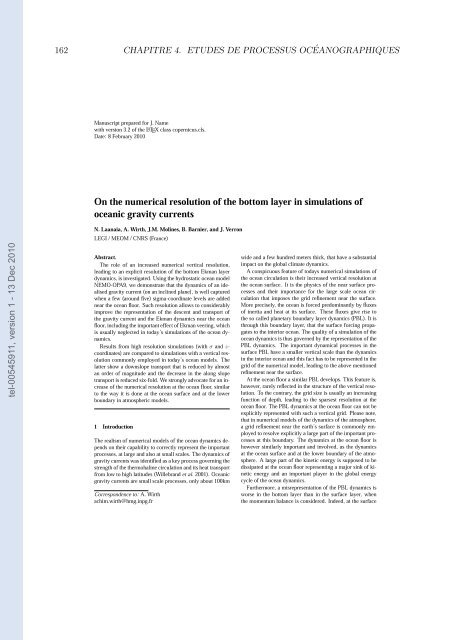Etudes et évaluation de processus océaniques par des hiérarchies ...
Etudes et évaluation de processus océaniques par des hiérarchies ...
Etudes et évaluation de processus océaniques par des hiérarchies ...
You also want an ePaper? Increase the reach of your titles
YUMPU automatically turns print PDFs into web optimized ePapers that Google loves.
162 CHAPITRE 4. ETUDES DE PROCESSUS OCÉANOGRAPHIQUES<br />
Manuscript pre<strong>par</strong>ed for J. Name<br />
with version 3.2 of the LATEX class copernicus.cls.<br />
Date: 8 February 2010<br />
tel-00545911, version 1 - 13 Dec 2010<br />
On the numerical resolution of the bottom layer in simulations of<br />
oceanic gravity currents<br />
N. Laanaia, A. Wirth, J.M. Molines, B. Barnier, and J. Verron<br />
LEGI / MEOM / CNRS (France)<br />
Abstract.<br />
The role of an increased numerical vertical resolution,<br />
leading to an explicit resolution of the bottom Ekman layer<br />
dynamics, is investigated. Using the hydrostatic ocean mo<strong>de</strong>l<br />
NEMO-OPA9, we <strong>de</strong>monstrate that the dynamics of an i<strong>de</strong>alised<br />
gravity current (on an inclined plane), is well captured<br />
when a few (around five) sigma-coordinate levels are ad<strong>de</strong>d<br />
near the ocean floor. Such resolution allows to consi<strong>de</strong>rably<br />
improve the representation of the <strong>de</strong>scent and transport of<br />
the gravity current and the Ekman dynamics near the ocean<br />
floor, including the important effect of Ekman veering, which<br />
is usually neglected in today’s simulations of the ocean dynamics.<br />
Results from high resolution simulations (with σ and z-<br />
coordinates) are com<strong>par</strong>ed to simulations with a vertical resolution<br />
commonly employed in today’s ocean mo<strong>de</strong>ls. The<br />
latter show a downslope transport that is reduced by almost<br />
an or<strong>de</strong>r of magnitu<strong>de</strong> and the <strong>de</strong>crease in the along slope<br />
transport is reduced six-fold. We strongly advocate for an increase<br />
of the numerical resolution at the ocean floor, similar<br />
to the way it is done at the ocean surface and at the lower<br />
boundary in atmospheric mo<strong>de</strong>ls.<br />
1 Introduction<br />
The realism of numerical mo<strong>de</strong>ls of the ocean dynamics <strong>de</strong>pends<br />
on their capability to correctly represent the important<br />
processes, at large and also at small scales. The dynamics of<br />
gravity currents was i<strong>de</strong>ntified as a key process governing the<br />
strength of the thermohaline circulation and its heat transport<br />
from low to high latitu<strong>de</strong>s (Willebrand <strong>et</strong> al. 2001). Oceanic<br />
gravity currents are small scale processes, only about 100km<br />
Correspon<strong>de</strong>nce to: A. Wirth<br />
achim.wirth@hmg.inpg.fr<br />
wi<strong>de</strong> and a few hundred m<strong>et</strong>ers thick, that have a substantial<br />
impact on the global climate dynamics.<br />
A conspicuous feature of todays numerical simulations of<br />
the ocean circulation is their increased vertical resolution at<br />
the ocean surface. It is the physics of the near surface processes<br />
and their importance for the large scale ocean circulation<br />
that imposes the grid refinement near the surface.<br />
More precisely, the ocean is forced predominantly by fluxes<br />
of inertia and heat at its surface. These fluxes give rise to<br />
the so called plan<strong>et</strong>ary boundary layer dynamics (PBL). It is<br />
through this boundary layer, that the surface forcing propagates<br />
to the interior ocean. The quality of a simulation of the<br />
ocean dynamics is thus governed by the representation of the<br />
PBL dynamics. The important dynamical processes in the<br />
surface PBL have a smaller vertical scale than the dynamics<br />
in the interior ocean and this fact has to be represented in the<br />
grid of the numerical mo<strong>de</strong>l, leading to the above mentioned<br />
refinement near the surface.<br />
At the ocean floor a similar PBL <strong>de</strong>velops. This feature is,<br />
however, rarely reflected in the structure of the vertical resolution.<br />
To the contrary, the grid size is usually an increasing<br />
function of <strong>de</strong>pth, leading to the s<strong>par</strong>sest resolution at the<br />
ocean floor. The PBL dynamics at the ocean floor can not be<br />
explicitly represented with such a vertical grid. Please note,<br />
that in numerical mo<strong>de</strong>ls of the dynamics of the atmosphere,<br />
a grid refinement near the earth’s surface is commonly employed<br />
to resolve explicitly a large <strong>par</strong>t of the important processes<br />
at this boundary. The dynamics at the ocean floor is<br />
however similarly important and involved, as the dynamics<br />
at the ocean surface and at the lower boundary of the atmosphere.<br />
A large <strong>par</strong>t of the kin<strong>et</strong>ic energy is supposed to be<br />
dissipated at the ocean floor representing a major sink of kin<strong>et</strong>ic<br />
energy and an important player in the global energy<br />
cycle of the ocean dynamics.<br />
Furthermore, a misrepresentation of the PBL dynamics is<br />
worse in the bottom layer than in the surface layer, when<br />
the momentum balance is consi<strong>de</strong>red. In<strong>de</strong>ed, at the surface
















